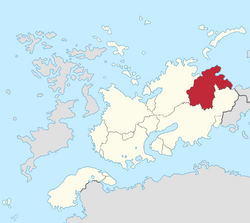Voshagne
This article is incomplete because it is pending further input from participants, or it is a work-in-progress by one author. Please comment on this article's talk page to share your input, comments and questions. Note: To contribute to this article, you may need to seek help from the author(s) of this page. |
Voshagne | |
|---|---|
 | |
| Country | |
| State | |
| Largest city | Novigrad |
| Area | |
| • Total | 1,157,271 km2 (446,825 sq mi) |
| Population (2015) | |
| • Total | 6,238,006 |
| • Density | 5.4/km2 (14/sq mi) |
| Demonym | Voshanees/ese |
Voshagne (/vɔshəni/; Voshanskya: Voshana; Vozhski: Vashań [vɔʂanʲ]) is a region of northwestern Lieseltania, comprosing of the provinces of Brest, Brunna, Castamere, Stakena, and Novigrad. It has an area of 1,157,271 km² (446,825 sq mi) and 6.2 million people.
Etymology
Geography
Subdivision
History
Prehistory
Slavic princely states
Northern War and the Voshan Wars
Lieseltanian Era
Forced explusions
Interior War
Following the end of the Third Voshan War and the Atmoran Civil War in 29 June 1946. The reestablished royalist government in Alexandria under the newly elected Chancellor Pieter-Bas Peusschers sought to bring stability back to the war-torn country with the disarmament of the royalist army and the partisans. However promiment communist and fascist figures in the Voshagne refused to put down their arms. Prominent communists Clemens Brunovsky and Emiel Morsinkhoff of the Nationale Volksweer rejected the demands of the Federal government in 17 May 1981. Brunovsky along with the Nationale Volksweer (NVU) rose in revolt against the federal government over the continued presence of the Nationale Volksunie the fascist terrorists in the Voshagne.
The leading cause of the communist revolts in the Voshagne are often pointed towards the death and rape of Christien Rostafiński in Novigrad. Christien Rostafiński was abducted by NVU members Karel Schaper and Jurrian Pellenkoft from her apartment in Novigrad on 13 May 1981. The Federal Police failed to act when Rostafiński's family notified them of her abduction. On the morning of 17 May, Rostafiński's body was discovered desecrated and hanging by a local couple outside of the St. Mary Magdalene's Cathedral. Outrage over the discovery of her remains and how Schaper and Pellenkoft desecrated her before her death. Ultimately led to Brunovsky and the National Volksweer to declare the formation of the Novigradskya Socialist Republic and the firefights in the city between the communists and fascist militia.
Modern era
Winter War
Demographics
Ethnic groups
The Voshagne is home to the Wends, Diebalsky, Wielzians, and the Milzenany along with the Nahane, Athabaskan, Mesties and the Inuit peoples, the recognised indigenous peoples of Northern Lieselania. Additionally the region is primarily inhabited by the Voshany and the Atmoran Noordlings, who came about settling with the Noordnederzetting along with Deportation of the Lieseltanian Slavs in the 18th century.
Prior to the northern settlements and the conquest of the Voshagne by Lieseltania the Slavic clans and the indigenous nations of the Voshagne resided in the Great Lakes Region. With the slavs primarily residing on the eastern banks of the lakes with the indigenous having the western highlands.
The largest ethnic groups in the Voshagne are 51.7% as Atmorans (3.225 million), 17.5% as Voshany (1.091 million), 14.3% as Slavs (892k), 13.76% as Indigenous (858k), 1.2% as Mizuhese (74.5k), and others (1.52%)
Religion
Religion in Voshagne (2016)
